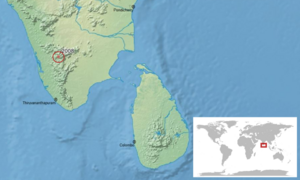Raorchestes griet facts for kids
Quick facts for kids Raorchestes griet |
|
|---|---|
 |
|
| Conservation status | |
| Scientific classification | |
 |
|
| Distribution of Raorchestes griet | |
| Synonyms | |
|
Philautus griet Bossuyt, 2002 |
The Griet bush frog (scientific name: Raorchestes griet) is a small frog that belongs to the Rhacophoridae family. This special frog lives only in the Western Ghats mountains of southern India. You can find it in the states of Kerala and Tamil Nadu, south of a place called the Palghat Gap.
The frog's scientific name, griet, was chosen to honor Griet Decock. She is the wife of Franky Bossuyt, the scientist who first found and described this species of frog.
Contents
About the Griet Bush Frog
What the Griet Bush Frog Looks Like
Adult male Griet bush frogs are about 20 to 22 millimeters (less than an inch) long. This is measured from their nose to their rear end. We only have one measurement for an adult female, which was 22 millimeters long.
Their snout, or nose area, is rounded. They have an eardrum, called a tympanum, but it is hard to see. There is a clear fold of skin above their eardrum.
The fingers of these frogs have well-developed discs at the ends. They also have small skin flaps, but no webbing between their fingers. Their toes also have discs and a small amount of webbing.
The skin on their snout has tiny, tough bumps. There are also tough ridges between their eyes, shaped like a triangle. The skin on their back is covered with small, tough bumps too.
The frog's back can be light grayish-brown, light brownish-gray, or light reddish-brown. Sometimes, they might have dark or light red markings on their skin.
Where the Griet Bush Frog Lives and How We Protect It
Griet Bush Frog's Home
The Griet bush frog has been seen living near roadsides. These areas are usually close to small forest patches or in plant farms near forests. They live at high places, from about 600 to 2000 meters (about 2,000 to 6,500 feet) above sea level.
These frogs are active at night. They are also arboreal, which means they live in trees and bushes. Male frogs make calls from the ground up to two meters (about six feet) high.
Scientists have seen these frogs on eucalyptus trees. However, they don't think the frogs can truly live and thrive in large eucalyptus farms. This is because these farms are often used for commercial purposes, which might not be good for the frogs.
Protecting the Griet Bush Frog
Even though these frogs can be found in large numbers in some places, they are still at risk. Their homes are being broken up by deforestation, which means forests are being cut down. This is called habitat fragmentation.
Also, people visiting the Western Ghats for yearly trips can sometimes disturb these frogs. Scientists are also worried about a fungus called Batrachochytrium dendrobatidis. This fungus can infect other frogs in the Raorchestes group. So, they believe it might also cause a disease called chytridiomycosis in the Griet bush frog.
Scientists also say that climate change is a threat to this frog. Changes in the climate can affect their habitat and survival.
Luckily, the Griet bush frog lives in several protected areas. These include Meghamalai Wildlife Sanctuary, Eravikulam National Park, Kodaikanal Wildlife Sanctuary, Anamalai Tiger Reserve, and Periyar Tiger Reserve. These parks help protect the frog and its home.


